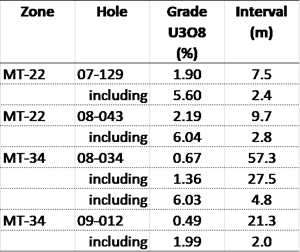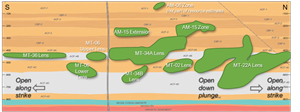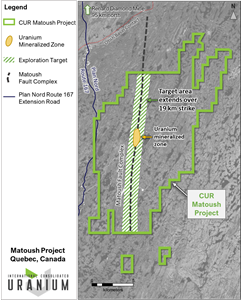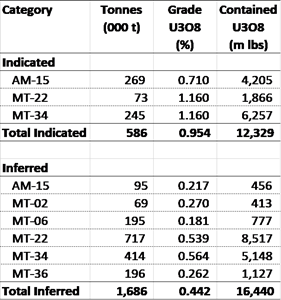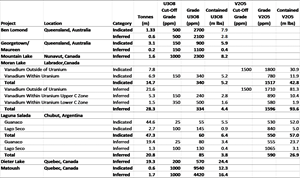International Consolidated Uranium Acquires the High-Grade Matoush Uranium Project in Quebec, Canada
VANCOUVER, British Columbia, May 11, 2021 (GLOBE NEWSWIRE) -- International Consolidated Uranium Inc. ("CUR" or the "Company") (TSXV: CUR) is pleased to announce that it has entered into a definitive share purchase agreement (the “Agreement”) whereby CUR will acquire a 100%, undivided interest, in the high-grade Matoush Uranium Project (“Matoush” or the “Property”) located in the Province of Quebec, Canada.
Key Points:
- High-Grade and Substantial Historic Resources – Based on a press release issued by Strateco Resources Inc. (“Strateco”) on December 7, 2012, Matoush was considered to have the following historical Mineral Resources:
- Indicated Mineral Resources of 586,000 t at an average grade of 0.954% containing 12.329 m lbs of U3O8
- Inferred Mineral Resources of 1,686,000 t at an average grade of 0.442% containing 16.44 m lbs of U3O8
- This historical estimate is considered to be a “historical estimate” under National Instrument 43-101 – Standards of Disclosure for Mineral Projects (“NI 43-101”) and is not considered by the Company to be current. See below under the heading “Global Historical Mineral Resource Table”.
- Advanced Stage Project – An Updated Preliminary Economic Assessment on the Property was published in April of 2010 which contemplated access via a ramp decline, mining using longhole methods followed by cemented rock fill (CRF).
- Good Exploration Potential – The Matoush Fault Zone, the structure that controls the mineralization, has been identified over a strike length extending 11km southward and 5km northward beyond the historic resource area. In addition, many of the zones of mineralization within the historic Mineral Resources are open along strike and down plunge.
- Proven Mining Jurisdiction with Uranium Endowment – Quebec ranks highly as a mining jurisdiction and has seen significant past expenditures on uranium exploration by both major and junior mining companies.
- Compelling Acquisition Structure – Deferred cash and share based consideration offers potential to reduce the ultimate total purchase price equity dilution.
Philip Williams, CEO commented, “We are very pleased to add another high-grade, advanced stage project, in a top ranked mining jurisdiction, to our global project portfolio. As with our other projects, Matoush was the subject of significant past exploration and economic evaluation work. It stands out for its high-grade and sizeable historical resource, ranking as one of the highest-grade undeveloped uranium projects outside of the Athabasca Basin in Saskatchewan as well as its promising exploration potential. We look forward to bringing a fresh perspective to development of the project with a focus on engagement with the local indigenous stakeholders before undertaking any project level activity. We recognize that uranium mining can be a lightning rod issue and, as such, it is incumbent on us to garner social acceptance before attempting to advance a project. Fortunately, uranium mining in Canada, under the strict regulation of the Canadian Nuclear Safety Commission, has an excellent track record with studies showing no significant impacts to the health of the public living near uranium mines or mills. Canada's long-standing experience in uranium mining has resulted in the development of stringent regulations and leading practices for the protection of health and safety of persons and the environment which, of course, we intend to adhere to fully.”
Terms of the Share Purchase Agreement
Pursuant to the Agreement, CUR will acquire 100% of the shares of a special purpose vehicle (the “SPV”) that holds a 100%, undivided interest, in the Property. The SPV, an indirect wholly-owned subsidiary of certain funds managed or advised by Third Eye Capital Corporation or its affiliates, acquired the Property free and clear of any encumbrances pursuant to an approval and vesting order granted by the Quebec Superior Court dated April 30, 2021 (the “Vesting Order”). The consideration payable by CUR pursuant to the Agreement on closing includes the issuance of such number of common shares in the capital of the Company (“Shares”) with a value of $3,000,000 at a price per Share based on the 20-day VWAP of the Shares on the TSX Venture Exchange (the “TSXV”) up to the date immediately prior to closing of the transaction, subject to a minimum of 2,000,000 Shares, and a cash payment of $3,500,000. A further deferred payment is due on or before the six-month anniversary of closing of the transaction comprised of such number of Shares with a value of $2,000,000 based on a price per Share based on the 20-day VWAP of the Shares on the TSXV up to the date prior to the deferred payment and $1,500,000 in cash.
Closing of the transaction is subject to satisfaction of certain closing conditions including, among other things, the approval of the TSX Venture Exchange. All securities issued in connection with the Agreement are subject to a hold period expiring four months and one day from the date of issuance.
The Matoush Uranium Project
The Property is an advanced stage exploration project centrally located in the Province of Quebec, 210 km north of the Cree community of Mistissini and approximately 275 km north of the town of Chibougamau. The Property currently comprises 413 mining claims covering a total area of 21,670 hectares (217 km2). The overall project area extends ~24 kilometers from north to south and up to 12 kilometers in width.
Uranium was first discovered on the Property by Uranerz Energy Corp. in 1980 with subsequent work by Ditem Exploration Inc. who optioned the property to Strateco in 2005 who has held the property since then. Mineralization at Matoush is similar to Athabasca unconformity type uranium deposits with regard to its occurrence in Proterozoic sedimentary rocks exhibiting similar alteration styles and structural controls. A notable divergence in the nature deposit at Matoush from the typical Athabasca style deposit is the lack of uranium mineralization at the actual unconformity. Uranium mineralization at Matoush occurs primarily in relatively flat lying accumulations between 150m and 600m above the basement unconformity within Indicator Formation Sandstones where they are breeched by structures. The penetrating structures have acted as conduits for the flow of mineralizing fluids and are often themselves associated with more steeply dipping zones of mineralization. It should be noted that mineralization is consistent with and roughly the same age as the Westmoreland Uranium project located in Queensland Australia.
Higher-grade uranium mineralization typically sits in unit 3 of the host formation, which is a series of active channel facies, consisting of coarse-grained sandstones and poorly sorted pebble conglomerates. Unit 3 ranges in thickness from as little as 11m up to 457m at the western end of the basin with an increase in lithological heterogeneity as it thickens. The best grade mineralization is hosted in a pebble conglomerate with pebbles to 2 cms adjacent to the Matoush fault. High-grade mineralization has a strong structural control in addition to a specific host lithology, namely coarse-grained active channel facies sandstones and conglomerates. To view the table that includes select high-grade drill results please visit: https://www.globenewswire.com/NewsRoom/AttachmentNg/9c598427-505b-4adf-ae84-fb2845d09755
Prominent structural controls on mineralization include the basement penetrating Matoush Fault Zone which has been shown to host mineralization intermittently along three kilometers of its strike length. Uranium mineralization is typically associated with intersections between the Matoush Fault Zone and apparent paleo aquifers.
The Matoush uranium mineralization occurs within a much broader alteration envelope and is characterized by replacement style disseminations and clots of fine-grained uraninite plus, in the higher-grade areas, semi-massive veins of uraninite. Yellowish orange, secondary uranophane is also present. The mineralization is distributed on both sides of the steeply dipping MFZ but is generally thicker on the south or hanging wall side. True widths of mineralized zones range from 1 m to 20 m. Geochemically, the mineralization is characterized by Cr, V, Co, Ni, Pb, Zn, Cu, Bi, Au, Se and Te. From its original and shallower drilling, Uranerz recognized a zoned alteration halo up to 50 m wide developed symmetrically around the Matoush Fault Zone and consisting of an inner tourmaline zone surrounded by a magnesium-chlorite and Cr-V muscovite zone. Hematite and limonite form the outermost halo.
Exploration potential within the project area is considered positive as mineralization is open to both the north and south along strike from the existing resource.
Matoush Project example stratigraphic section showing mineralised lenses. Open along strike and down plunge. (Roscoe Postle Associates Inc, 2012): https://www.globenewswire.com/NewsRoom/AttachmentNg/e59d3bee-44f8-47b9-98ba-1aeef341352a
In addition, favourable geological units, to host mineralization, occur abutting the Matoush Fault zone for 5 kilometers north and up to 11 kilometers south of the main zone of mineralization.
To view the related infographic appearing here in the release, please visit: https://www.globenewswire.com/NewsRoom/AttachmentNg/0b535535-54fa-4fc6-bc34-41985fa82f5c
In the Property area, 538 drill holes totaling approximately 234,707 metres have been completed. These include 415 holes (188,123 m) in the main Matoush historic resource area and extensions.
Historic Mineral Resources
Roscoe Postle Associates Inc. (“RPA”), an independent consulting company, prepared a technical report on the Property in accordance with the disclosure standards of NI 43-101 entitled “Technical Report on the Mineral Resource Update for the Matoush Project, Central Québec, Canada” dated February 12, 2012. The Mineral Resource estimate was further updated by RPA in December 2012, as disclosed in a press release of Strateco dated December 7, 2012 (the “Historic Estimate”) and is considered to be a “historical estimate” under NI 43-101 and is not considered by the Company to be current. See below under the heading “Global Historical Mineral Resource Table”.
The Historic Estimate used drill hole data available as of November 22, 2012. A set of cross-sections and plan views were used to construct three-dimensional wireframe models at a cut-off grade of 0.1% U3O8. High-grade values were cut to 9% U3O8 prior to compositing. Variogram parameters were interpreted from two-metre composited values. Block U3O8 grades within the wireframe models were estimated by ordinary kriging.
The Historic Estimate was reported to be contained within six zones: AM-15, MT-22, MT-34, MT-02, MT-06, and MT-36 as shown in the following table: https://www.globenewswire.com/NewsRoom/AttachmentNg/774d28b4-95df-40a6-a362-82e2a285026c
Notes:
1. CIM definitions were followed for the Historic Estimate.
2. The Historic Estimate was estimated at a cut-off grade of 0.1% U3O8.
3. The Historic Estimate was estimated using an average long-term uranium price of US$75 per pound.
4. A minimum mining width of 1.5 m was used.
5. The MT34A lens is within both the MT-34 and AM-15 zones.
6. Numbers may not add due to rounding.
Global Historic Mineral Resource Table
The table below sets out the historical Mineral Resource estimates for each project CUR currently owns outright or on which it has announced an option agreement, including Matoush. The Mineral Resource estimate for each project is considered to be a “historical estimate” under NI 43-101 and is not considered by the Company to be current.
To view the table mentioned in the paragraph above, please visit: https://www.globenewswire.com/NewsRoom/AttachmentNg/a4d87441-c021-4581-9552-d5d0dd33194f
Technical Disclosure and Qualified Person
The scientific and technical information contained in this news release was prepared by Peter Mullens (FAusIMM), CUR’s VP Business Development, who is a “Qualified Person” (as defined in NI 43-101).
Each of the above estimates are considered to be “historical estimates” as defined under NI 43-101, and have been sourced as follows:
- Ben Lomond: dated as of 1982, and reported by Mega Uranium Ltd. in a company report entitled “Technical Report on the Mining Leases Covering the Ben Lomond Uranium-Molybdenum Deposit Queensland, Australia” dated July 16, 2005;
- Georgetown/Maureen: dated as of June 25, 2008, and reported by Mega Uranium Ltd. in a company report entitled “A Review and Resource Estimate of the Maureen Uranium-Molybdenum Deposit, North Queensland, Australia Held by Mega Uranium Ltd.” dated June 25, 2008;
- Mountain Lake: dated as of February 15, 2005 and reported by Triex Mineral Corporation in a company report entitled “Mountain Lake Property Nunavut” dated February 15, 2005;
- Moran Lake: dated as of January 20, 2011 as revised March 10, 2011 and reported by Crosshair Exploration & Mining Corp. in a company report entitled “Technical Report on the Central Mineral Belt (CMB) Uranium – Vanadium Project, Labrador, Canada” dated January 20, 2011 as revised March 10, 2011;
- Laguna Salada: dated as of May 20, 2011 and reported by U3O8 Corporation in a company report entitled “NI 43-101 Technical Report Laguna Salada Initial Resource Estimate” dated May 20, 2011; and
- Dieter Lake: dated 2006 and reported by Fission Energy Corp. in a company report entitled “Technical Report on the Dieter Lake Property, Quebec, Canada” dated October 7, 2011.
- Matoush: dated December 7, 2012 and reported by Strateco Resources Inc. in a press release dated December 7, 2012.
In each instance, the historical estimate is reported using the categories of Mineral Resources and Mineral Reserves as defined by NI 43-101, but is not considered by the Company to be current. In each instance, the reliability of the historical estimate is considered reasonable, but a Qualified Person has not done sufficient work to classify the historical estimate as a current Mineral Resource and the Company is not treating the historical estimate as a current Mineral Resource. The historical information provides an indication of the exploration potential of the properties but may not be representative of expected results.
For Ben Lomond, as disclosed in the above noted technical report, the historical estimate was prepared by The Australian Atomic Energy Commission (AAEC) using a sectional method. The parameters used in the selection of the ore intervals were a minimum true thickness of 0.5 metres and maximum included waste (true thickness) of 5 metres. Resource zones were outlined on 25 metre sections using groups of intersections, isolated intersections were not included. The grades from the composites were area weighted to give the average grade above a threshold of 500 ppm uranium. The area was measured on each 25 metre section to give the tonnage at a bulk density of 2.603. The Company would need to conduct an exploration program, including twinning of historical drill holes in order to verify the Ben Lomond historical estimate as a current Mineral Resource.
For Georgetown/Maureen, as disclosed in the above noted technical report, the historical estimate was prepared by Mining Associates using a block model estimation methodology. Resource modelling was carried out on a database comprising 94,810 metres of combined drilling. Using a variety of estimation techniques, a 5x5x5 metre block model was constructed. This defined the shallow westward-dipping mineralization mantos which contain the higher grade zones. The Company would need to conduct an exploration program, including twinning of historical drill holes in order to verify the Georgetown/Maureen historical estimate as a current Mineral Resource.
For Mountain Lake, as disclosed in the above noted technical report, the historical estimate was prepared by F.R. Hassard, B.A.Sc., P. Eng. (Qualified Person) using the polygon method. The resource estimate was based on a minimum grade of 0.1% U3O8, a minimum vertical thickness of 1.0 metre and specific gravity of 2.5. The Company would need to conduct an exploration program, including twinning of historical drill holes in order to verify the Mountain Lake historical estimate as a current Mineral Resource.
For Moran Lake, as disclosed in the above noted technical report, the historical estimate was prepared by C. Stewart Wallis P. Geo, Barry A. Sparkes, P. Geo., Gary H. Giroux, P. Eng. (Qualified Person) using three-dimensional block models utilizing ordinary kriging to interpolate grades into each 10m x 10m x 4m high block. For the purpose of the vanadium resource estimate, a vanadium specific model was created in the Upper C rock package above the C Zone thrust fault. The vanadium model is based on a wireframe solid defining the vanadium mineralized envelope using an external cut-off of approximately 0.1% V2O5. For the purposes of the estimates, a specific gravity of 2.83 was used. The Company would need to conduct an exploration program, including twinning of historical drill holes in order to verify the Moran Lake historical estimate as a current Mineral Resource.
For Laguna Salada, as disclosed in the above noted technical report, the historical estimate was prepared by Coffey Mining Pty. Ltd. using block models utilizing ordinary kriging to interpolate grades into each 1000m x 1000m x 10m parent cell. For the purposes of the estimate, bulk density of 1.7t/m³ was used for Lago Seco and 1.95t/m³ for Guanaco. The Company would need to conduct an exploration program, including trenching in order to verify the Laguna Salada historical estimate as a current Mineral Resource.
For Dieter Lake, as disclosed in the above noted technical report, the historical estimate was prepared by Davis & Guo using the Thiessen (Voronoi) polygon method. Data constraints used were 200 ppm, 500 ppm, and 1000ppm U3O8 over a minimum of 1 metre thickness. Polygons created had radii of 200 metres. A rock density of 2.67g/cm3 was used. The Company would need to conduct an exploration program, including twinning of historical drill holes in order to verify the Dieter Lake historical estimate as a current Mineral Resource.
For Matoush, as disclosed in the above noted press release, the historical estimate was prepared by RPA using block U3O8 grades within a wireframe model that were estimated by ordinary kriging. The historical estimate was estimated at a cut-off grade of 0.1% U3O8 and using an average long-term uranium price of US$75 per pound. Six zones make up the historical estimate at Matoush: AM-15, MT-34, MT-22, MT-02, MT-06, and MT-36. Each zone is made up of one or more lenses, most of which strike north (009°) and dip steeply (87°) to the east. Outlines of the mineralized lenses were interpreted on ten-metre spaced vertical sections. Minimum criteria of 0.10% U3O8 over 1.5 m true thickness was used as a guide. The Company would need to conduct an exploration program, including twinning of historical drill holes in order to verify the Matoush historical estimate as a current Mineral Resource.
About International Consolidated Uranium
International Consolidated Uranium Inc. (formerly, NxGold Ltd.) is a Vancouver-based exploration and development company. The Company has entered option agreements to acquire five uranium projects in Australia, Canada and Argentina each with significant past expenditures and attractive characteristics for development; with Mega Uranium Ltd. (TSX: MGA) the right to acquire a 100% interest in the Ben Lomond and Georgetown uranium projects in Australia; with IsoEnergy Ltd. (TSXV: ISO) the right to acquire a 100% interest in the Mountain Lake uranium project in Nunavut, Canada; with a private individual the right to acquire a 100% interest in the Moran Lake uranium and vanadium project in Labrador, Canada; and with U3O8 Corp. (TSXV: UWE.H), the right to acquire a 100% interest in the Laguna Salada uranium and vanadium project in Argentina. The Company entered into the Mountain Lake option agreement with IsoEnergy on July 16, 2020, and the transaction remains subject to regulatory approval, as does the transaction with U3O8 Corp. on the Laguna Salada Project. In addition, the Company owns 80% of the Mt. Roe gold project located in the Pilbara region of Western Australia and has entered into an earn-in agreement with Meliadine Gold Ltd. to earn up to a 70% interest in the Kuulu Project (formerly known as the Peter Lake Gold Project) in Nunavut.
Philip Williams
President and CEO
International Consolidated Uranium Inc.
+1 778 383 3057
pwilliams@consolidateduranium.com
Neither TSX Venture Exchange nor its Regulations Services Provider (as that term is defined in policies of the TSX Venture Exchange) accepts responsibility for the adequacy or accuracy of this release.
Cautionary Statement Regarding Forward-Looking Information.
This news release contains "forward-looking information" within the meaning of applicable Canadian securities legislation. “Forward-looking information” includes, but is not limited to, statements with respect to activities, events or developments that the Company expects or anticipates will or may occur in the future including whether the proposed acquisition will be completed and the work required to verify the historical estimates as a current Mineral Resources. Generally, but not always, forward-looking information and statements can be identified by the use of words such as “plans”, “expects”, “is expected”, “budget”, “scheduled”, “estimates”, “forecasts”, “intends”, “anticipates”, or “believes” or the negative connotation thereof or variations of such words and phrases or state that certain actions, events or results “may”, “could”, “would”, “might” or “will be taken”, “occur” or “be achieved” or the negative connotation thereof.
Such forward-looking information and statements are based on numerous assumptions, including that general business and economic conditions will not change in a material adverse manner, that financing will be available if and when needed and on reasonable terms, and that third party contractors, equipment and supplies and governmental and other approvals required to conduct the Company’s planned exploration activities will be available on reasonable terms and in a timely manner. Although the assumptions made by the Company in providing forward-looking information or making forward-looking statements are considered reasonable by management at the time, there can be no assurance that such assumptions will prove to be accurate.
Forward-looking information and statements also involve known and unknown risks and uncertainties and other factors, which may cause actual events or results in future periods to differ materially from any projections of future events or results expressed or implied by such forward-looking information or statements, including, among others: whether the conditions to completion of the acquisition will be satisfied, negative operating cash flow and dependence on third party financing, uncertainty of additional financing, no known mineral reserves or resources, reliance on key management and other personnel, potential downturns in economic conditions, actual results of exploration activities being different than anticipated, changes in exploration programs based upon results, and risks generally associated with the mineral exploration industry, environmental risks, changes in laws and regulations, community relations and delays in obtaining governmental or other approvals.
Although the Company has attempted to identify important factors that could cause actual results to differ materially from those contained in the forward-looking information or implied by forward-looking information, there may be other factors that cause results not to be as anticipated, estimated or intended. There can be no assurance that forward-looking information and statements will prove to be accurate, as actual results and future events could differ materially from those anticipated, estimated or intended. Accordingly, readers should not place undue reliance on forward-looking statements or information. The Company undertakes no obligation to update or reissue forward-looking information as a result of new information or events except as required by applicable securities laws.

